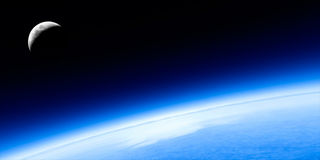Artificial Intelligence
Space 2.0: Stanford Using AI to Democratize Space
Crowdsourcing AI machine learning for a “tow truck” in space
Posted February 10, 2019

There is a large and growing environmental problem that is not on this Earth—it’s trash orbiting our planet in space. Space debris is a not only an economic risk that can affect every day modern living, but also it is an existential risk that jeopardizes the ability for scientists to research weather and climate changes that impact all living things on Earth. In early February 2019, researchers from Stanford University’s Space Rendezvous Laboratory (SLAB) announced a plan to crowdsource artificial intelligence (AI) to solve the massive problem of orbiting space debris.
Simone D’Amico, founder and director of the Stanford's Space Rendezvous Lab, is partnering with the European Space Agency (ESA) to create an AI system that will provide navigational guidance to a space “tow truck” in order to identify, fix or remove defunct, orbiting satellites that are above the atmosphere, yet doomed to orbit due to the gravitational pull of the Earth.
How can artificial intelligence solve the problem of space debris?
D’Amico is shifting the paradigm of scientific space research by casting a wide net. Crowdsourcing is the method of achieving project objectives by inviting a large group of contributors. Typically crowdsourcing is done online, and is significantly less expensive than traditional methods of obtaining contribution.
Stanford's Space Rendezvous Lab and the European Space Agency launched online on February 1, 2019 a global competition for AI machine learning laboratories to create algorithms trained on SLAB’s database of 16,000 images that will help improve the performance of the AI navigation system that is already in development by SLAB.
How big is the problem of space debris?
According to the European Space Agency, over 5,250 launches have sent 42,000 tracked objects into Earth’s orbit in the 62 years since the launch of the first satellite, Sputnik 1, in 1957. Today, the ESA estimates that out of the 23,000 objects orbiting the Earth, only 5 percent (1,200) are functioning satellites—the remaining 95 percent are either defunct satellites (3,200) or bits of space junk (18,600 pieces of debris).
However, these are just estimates. The exact quantity and location of space debris orbiting the Earth is unknown. This makes it challenging for satellite operators to avoid collisions with the orbiting rubbish.
Space debris is a massive economic risk to stakeholders of satellite technology. Launching a satellite is a costly endeavor—pricing depending on the manufacturer. Even on the lower end of pricing, a single satellite costs millions of dollars. For example, SpaceX, founded by Elon Musk, charges per launch an estimated $62 million for the Falcon 9, and $90 million for the Falcon Heavy. On the higher end of cost, according to U.S. Airforce figures, a United Launch Alliance (ULA) costs an estimated $422 million per launch in fiscal year 2020.
Floating orbiting bits of trash poses a hazard to functioning satellites. For example, two intact satellites, an operational American Iridium 33 and a deactivated Russian Kosmos 2251, accidentally collided in space in 2009, generating even more scrap waste materials orbiting the Earth that pose a threat to functioning satellites.
Why bother cleaning up orbiting trash?
Space debris represent a risk to the services that we use on a daily basis. If you make a phone call, watch TV, or drive a car, chances are that you are using services that rely upon satellite technology. Television, telecommunications, weather services, and GPS (Global Positioning System) are a few examples of the services that orbiting satellites provide. Any disruption those services can negatively impact businesses and wreak havoc in how we communicate, work, travel, socialize, and play.
National Aeronautics and Space Administration (NASA) scientists use satellite information for weather and climate research. According to recent figures released earlier this week from NASA and the National Oceanic and Atmospheric Administration (NOAA), last year it was 1.49 degrees Fahrenheit (0.83 degrees Celsius) warmer than during the period 1951-1980—it was the fourth warmest year of record. Changes in climate is an existential threat that affects the Earth’s ecosystems and all forms of life—plants, animal, and humans. Having a way to study the changes in the environment is important for the survival of all species on Earth.
Copyright © 2019 Cami Rosso All rights reserved.
References
Meyers, Andrew (2019, Feb.1). “Stanford develops an AI navigation system for a future satellite ‘tow truck’.” Stanford News. URL: https://news.stanford.edu/2019/02/01/stanford-spurs-ai-navigation-space…
NASA. “What Is a Satellite?” Retrieved 2-9-2019 from https://www.nasa.gov/audience/forstudents/5-8/features/nasa-knows/what-…
Milman, Oliver. “2018 was world's fourth hottest year on record, scientists confirm.” The Guardian. 6 Feb 2019.
Berger, Eric. “Air Force budget reveals how much SpaceX undercuts launch prices.” Ars Technica. 6/15/2017.
Schmidt, Gavin A., Arndt, Deke. “Annual Global Analysis for 2018 - 2018 was 4thwarmest for globe, 3rdwettest for US.” NOAA/NASA. February 2019. Retrieved 2-9-2019 from https://www.ncdc.noaa.gov/sotc/briefings/201902.pdf
NASA. “Sputnik and The Dawn of the Space Age.” Retrieved 2-8-2019 from https://history.nasa.gov/sputnik/
Scitech Europa. “Solving the challenges of active space debris.” Scitech Europa Quarterly. 7 August 2018.
Globalcom. “The Cost of Building and Launching a Satellite.” Retrieved 2-8-2019 from https://www.globalcomsatphone.com/hughesnet/satellite/costs.html
Tuttle, Brad. “Here's How Much It Costs for Elon Musk to Launch a SpaceX Rocket.” Money. February 6, 2018.
BBC News. “Russian and US satellites collide.” BBC. 12 February 2009.




